

 This is a Blue Mazda Bulb manufactured by Westinhouse dating from the early 1920's. Note the clear tip. This is the bulb I chose for the background.
This is a Blue Mazda Bulb manufactured by Westinhouse dating from the early 1920's. Note the clear tip. This is the bulb I chose for the background.
Dating from the early teens....
 Note the the spiral filament. The original red lacquer has been chipped over the years.
Note the the spiral filament. The original red lacquer has been chipped over the years.
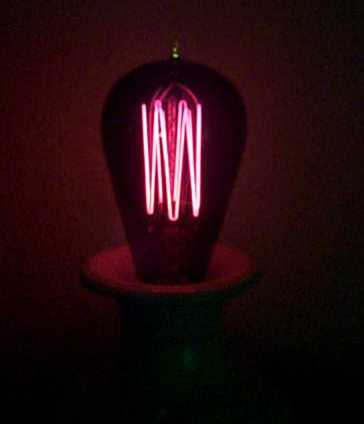 And this one is another Westinghouse Mazda dating from the early twenties- Note how the filaments of this and blue mazda differ from the Mazda of the teens, and light bulbs of today. This manner of construction is expensive, and is only in use today in reproduction light bulbs a handful of projection bulbs of high power output. All of these Mazdas on this page are rated at 40 Watts only. In the early days of motion pictures, light bulbs were not capable of producing adequate light output (expressed as "lumens"), and Carbon Arc was the only method capable of developing adequate light for projection purposes at the time. In those days, the maximum size of a reel was limited by the length of time an arc could be sustained until there was no carbon electrode left- The realistic life of one set of carbons was approximately 20-22 minutes. This meant one reel of projection film was 20 minutes on average to an absolute maximum of 22 minutes. This is what those marks up in the corners are that are visible in older films are for, so the projectionist knows to start the other projector. Sometimes these marks can still seen today at times when the film is meant for theaters where they are not fully automated. The life span of the carbon arc electrodes is where film lengths came to be known as "reelers", or "reels". Feature length films were usually 4 to 6 reals long (except for a few expansive motion pictures by Cecil B. DeMill and a few others.). Laurel and Hardy movies usaually tended to be anywhere from a single reel on up to feature length 6 "reelers". And episode serials usually were 1 reel per episode. Some of these later got spliced into feature length films, such as a number of "Buck Rogers" and "Flash Gordon" films were.
And this one is another Westinghouse Mazda dating from the early twenties- Note how the filaments of this and blue mazda differ from the Mazda of the teens, and light bulbs of today. This manner of construction is expensive, and is only in use today in reproduction light bulbs a handful of projection bulbs of high power output. All of these Mazdas on this page are rated at 40 Watts only. In the early days of motion pictures, light bulbs were not capable of producing adequate light output (expressed as "lumens"), and Carbon Arc was the only method capable of developing adequate light for projection purposes at the time. In those days, the maximum size of a reel was limited by the length of time an arc could be sustained until there was no carbon electrode left- The realistic life of one set of carbons was approximately 20-22 minutes. This meant one reel of projection film was 20 minutes on average to an absolute maximum of 22 minutes. This is what those marks up in the corners are that are visible in older films are for, so the projectionist knows to start the other projector. Sometimes these marks can still seen today at times when the film is meant for theaters where they are not fully automated. The life span of the carbon arc electrodes is where film lengths came to be known as "reelers", or "reels". Feature length films were usually 4 to 6 reals long (except for a few expansive motion pictures by Cecil B. DeMill and a few others.). Laurel and Hardy movies usaually tended to be anywhere from a single reel on up to feature length 6 "reelers". And episode serials usually were 1 reel per episode. Some of these later got spliced into feature length films, such as a number of "Buck Rogers" and "Flash Gordon" films were.



The key is to measure the "fitter"- The dimension on the fixture that the globe has to fit inside to be retained by the retaining screws. Older globes are going to be either a closer fit than you may expect, or they may be slightly smaller than expected. It is for this reason that you see porcelain fitter bases on these globes pictured here instead of the cheap modern steel ones- Which can work, but you need to pay close attention to the amount of threads coming through the metal fitter base. I do have vintage globes on the small lights on two ceiling fans, and they fit snug, but I have to be careful when relamping that I do not knock the globe loose because the retaining screws on one fan thread in only perhaps 4 full threads, or less; there is "just enough" for the screw not to pull out/fall out.
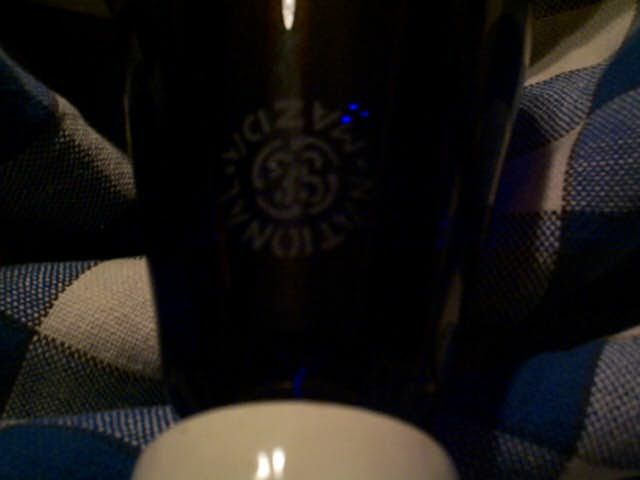 The Westinghouse markings on the Blue Mazda...
The Westinghouse markings on the Blue Mazda...
 The Westinghouse markings on the clear Mazda match these as far as the etched markings, but this clear still has the paper tag which barely able to be read in this image....
The Westinghouse markings on the clear Mazda match these as far as the etched markings, but this clear still has the paper tag which barely able to be read in this image....
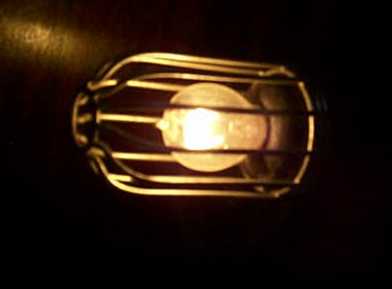

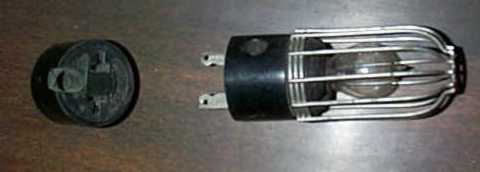
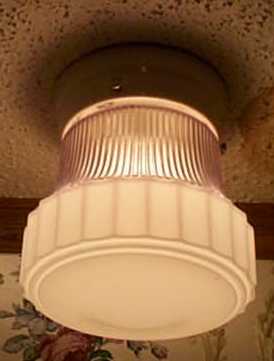 One nice tasteful example to come from the post war era is this one, I do not know who the manufacturer was, the designer, or the actual date this was introduced, but I have a fair amount of reference material to suggest this came out with a fair amount of "French Provincial" revival that pretty much began in 1941, put on hold for the war, then came out full force after the war- But then dropped out of fashion as "Danish Modern" and the "Jet Age" hit the scene.
It may not be evident on your monitor, but there is a faint purple shade to the whole globe. Compare it to the white porcelain base that retains it. The camera renders in a bit of a yellow shading to everyhting in this image, but if you were to adjust the image to reduce the yellow, you would make out the shading.
One nice tasteful example to come from the post war era is this one, I do not know who the manufacturer was, the designer, or the actual date this was introduced, but I have a fair amount of reference material to suggest this came out with a fair amount of "French Provincial" revival that pretty much began in 1941, put on hold for the war, then came out full force after the war- But then dropped out of fashion as "Danish Modern" and the "Jet Age" hit the scene.
It may not be evident on your monitor, but there is a faint purple shade to the whole globe. Compare it to the white porcelain base that retains it. The camera renders in a bit of a yellow shading to everyhting in this image, but if you were to adjust the image to reduce the yellow, you would make out the shading.
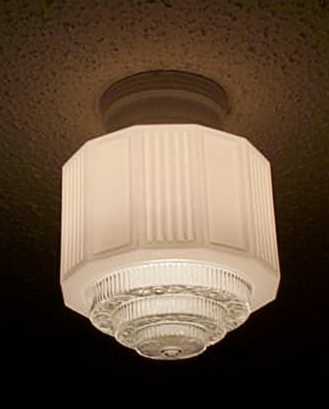 Something a lot of people fail to realize when they have a modern ceiling fan, depending upon which style you chose, you are not required to live with that uninspired cheap globe that came with the fan- You can use the vintage light globes instead. Below is one example that almost wound up on my ceiling fan in the basement, but there would have been zero headroom under it for someone even 5 foot 10; but a different story if I had 9 or 10 foot ceilings.
Something a lot of people fail to realize when they have a modern ceiling fan, depending upon which style you chose, you are not required to live with that uninspired cheap globe that came with the fan- You can use the vintage light globes instead. Below is one example that almost wound up on my ceiling fan in the basement, but there would have been zero headroom under it for someone even 5 foot 10; but a different story if I had 9 or 10 foot ceilings.

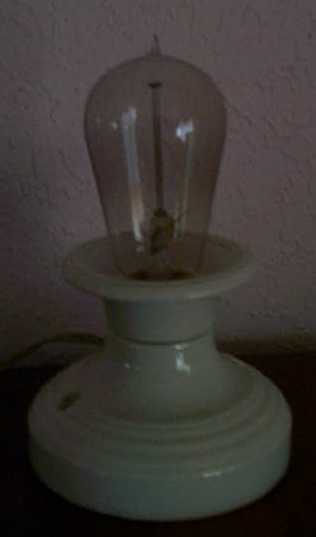
Random Site
[
Previous 5 Sites
|
Previous
|
Next
|
Next 5 Sites
|
Random Site
|
List Sites
]
